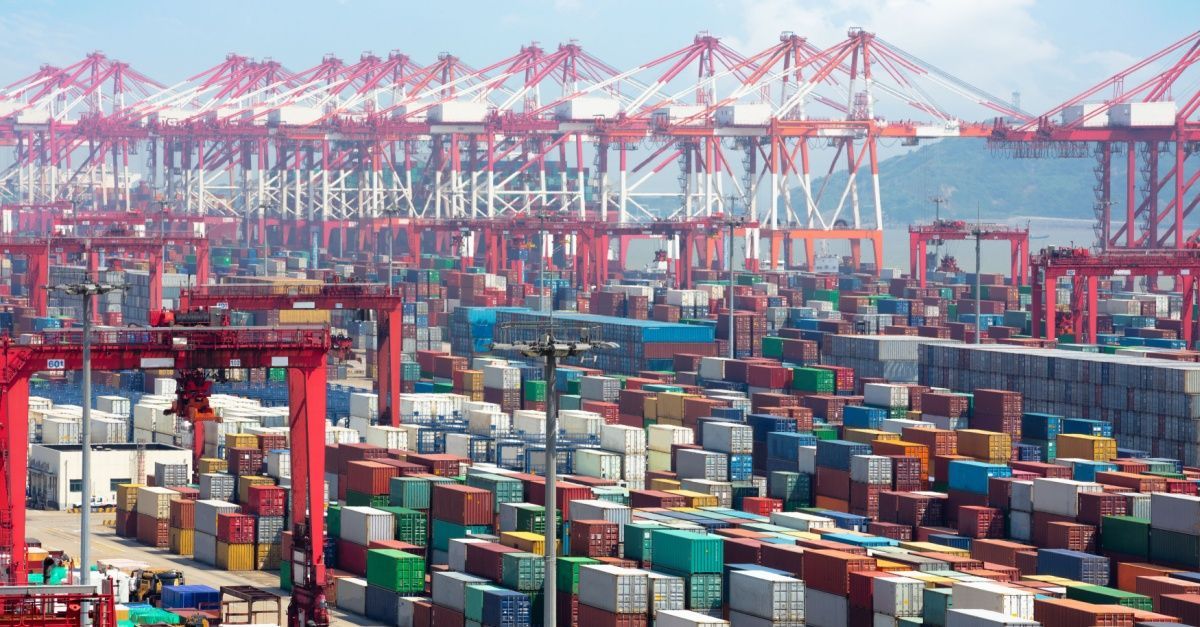A Refrigerated (Reefer) Transportation and Freight Best Practices Guide
Blog Post CTA
A Refrigerated (Reefer) Transportation and Freight Best Practices Guide
Frozen trucking companies and trucker team members offer a wide range of freight solutions and services that prove to be valuable to the country’s supply chains day in and day out. There is always a need to get food. drinks, and medical supplies from Point A to Point B. And this is an even bigger necessity during economic downturns and times of market instability.
The market demand for reefer freight transportation has been steadily growing and most likely will continue for the foreseeable future. According to GlobeNewswire, “the global refrigerated goods market is expected to grow from $47.54 billion in 2020 to $50.02 billion in 2021 at a compound annual growth rate (CAGR) of 5.2%...The market is expected to reach $59.27 billion in 2025 at a CAGR of 4.3%.” The growth within the market is primarily thanks to the upheaval of normal company operations as businesses shifted focus and continue recovering from the COVID-19 impacts.
To compensate for shortages in the trucking lanes and increased pressure on the supply chain overall, the need for more reefer trucking companies grew exponentially and continues to do so today with cold freight transfers.
What Do Reefer Trucking Companies Do?
By transporting goods that require particular temperature considerations, refrigerated trucks allow the consumer to get access to fresh produce, meat, medicines, and other products that otherwise would be difficult to ship long distances. A large number of trucks that run supply chain routes across the country today are refrigerated trucks, commonly known as reefer trucks in the industry.
Reefer transportation companies haul freight needing specialized and, at times, very specific temperature-controlled transportation environments. Trailers used for refrigerated freight have a built-in cooling system to ensure cargo remains at the correct temperature throughout the entire transportation process. A refrigerated trailer can usually keep freight at lower temperatures ranging from chilled to frozen. This protection is especially critical sensitive cargo shipments or when the outside temperatures and environment would lead to a ruined load.
Concerning refrigerated freight companies, goods must be handled, stored, loaded, and unloaded correctly to ensure temperature levels are adequately maintained. Skilled and experienced drivers who know how to handle reefer goods are invaluable in maintaining smooth shipping lanes and successful deliveries all across the country. The need for reefer carriers in the USA remains high as this is an essential piece of the modern supply chain puzzle. Reefer trucking companies can handle a range of cargo that we use every single day, including:
- Various drinks and beverages
- Fresh fruit and vegetables
- Chilled and frozen freight and goods
- Meat, cheese, and other perishables
- Various food items and condiments
- Medical supplies, medicines, vaccines
- Flowers, seeds, and plants
- Some beauty and cosmetics
- Live birds, livestock, and other animals
- Misc. supplies and products
Reefers have always been a critical part of the supply chain, and now, more than ever, they are in high demand. Refrigerated freight companies are one of the niche markets that rebounded fastest and have seen the strongest post-pandemic recovery.
Common Challenges Experienced in Refrigerated Freight Companies
Like all things in shipping and transportation, especially during such high pressure and uncertainty, some obstacles can arise with reefer freight transportation services. Reefer transportation companies may have to contend with the following challenges:
Damaged Equipment
Trucking fleets in general must ensure breakdowns and vehicle problems are kept to a minimum. A single breakdown can cause massive issues all along the supply chain. Reefer truckers must be even more mindful as added issues can arise with the cooling system and related components that can become damaged.
Loss of Temperature Controls
During transport, temperatures must remain stable, no matter the weather conditions outside the truck. Frozen goods must not be allowed to thaw out. This task is impossible when controls break down and don’t respond to programming, which is a fairly common reefer truck issue — especially with older trucks.
Limited Drivers Skilled and Licensed
There has been a driver shortage plaguing the transportation industry for some time now. It is even more obvious for a frozen trucking company as even fewer drivers can operate, monitor, control, and carry temperature-sensitive cargo. When these drivers have no available capacity, there are not enough drivers to fill in the gaps.
Poor Traceability of Temperature in Transit
Another significant issue facing refrigerated truck transportation companies today is trouble with automated tracking, monitoring, and reporting. Being unable to tell what conditions are like inside the cargo containers while en route is a major issue for refrigerated freight. It is something that relies on automated digital tracking services.
Reasons to Outsource Procurement of Transportation Carriers That Haul Refrigerated Freight
Shippers who need to move temperature-sensitive cargo and know with some level of certainty that their cargo will arrive safely at the final destination need transportation carriers who specialize in reefer freight. These refrigerator trucking companies provide many great benefits and offer several reasons why shippers should consider this option for all special projects and unique reefer shipping needs.
- Save time, money, resources. Partnering with refrigerated transport companies will give shippers the upper hand. In the long run, it will save them by making it easier to find the right carrier for every load.
- Gain more flexibility and more scalability. When carrier collaboration is one less thing to worry about, shippers can quickly react to market changes. Shifts in customer demand are less jarring with vetted carriers.
- Shipping niche-specific expertise. Another reason specialized carrier partnerships are beneficial is they allow for niche services. Shippers can address customer needs and secure capacity with a frozen trucking company.
- It’s about who you know in the market. Working with carriers long-term can open doors to new partnerships and new customer bases. Knowing reliable carriers is critical to successful retail shipping.
- Faster access to dense capacity. Connecting with reefer trucking companies makes it easier to maintain high capacity and density. Openings can be filled more easily, and trucks can be kept fuller at all times.
- Access to high-quality equipment. Partnering with refrigerated freight carriers also helps lessen the pressure on most shippers. They can gain access to trucks and other equipment they otherwise couldn’t.
- Much lower maintenance costs. Another reason why reefer carrier partnerships matter: they help lower maintenance and operational cost. Someone else can maintain and monitor the fleet day in and day out.
Shippers are under tremendous pressure to make good on promised deliveries and satisfy customers. Partnering with transportation carriers that haul refrigerated freight can make the entire process simpler and easier all around.
How to Assess the Viability and Value of Refrigerated Trucking Companies
In the refrigerated trucking business, the way cargo is handled and cared for is more critical than ever. Even the slightest temperature changes during shipping can harm overall shipping success, profits, and business reputation. The entire supply chain must be well-organized and efficient, and it all starts with reefer trucking service providers who offer top-notch services every time they pick up a load.
Reefer companies provide a valuable service that is also in high demand. A dedicated reefer carrier pool makes it easier for shippers to command better rates, increase customers’ service options, reduce deadhead miles, and provide exceptional services. Ensuring a current refrigerated company and carrier relationship is viable and valuable requires careful consideration of the following points.
- Profit versus losses within the company based on quarterly and annual comparisons.
- Short- and long-term goals along with KPIs and review points for freight metrics.
- Reputation within the industry for services, skills, experience, and reliability.
- Availability of drivers/carriers to fill needs and respond to urgent freight needs.
- Experience within niche markets and proven success with specialty freight loads.
- Relationships with growers and shippers and manufacturers across industries.
- An on-time delivery success rate that is better than that of the competition.
- The amount of damaged or ruined cargo due to reefer-related issues in transport.
- Frequency of disruption and exception compared to successful delivery handoffs.
- Average response speed and success of dealing with disruptions and issues.
- Customer reviews and satisfaction with current refer transportation services.
Reefer trucking and transportation services can have a tremendous positive impact on shippers. However, shippers must work with reefer trucking companies that provide viable and valuable services, no matter what market shifts may come along. Finding the right trucking company and the right reefer carrier will ensure future growth and success for shippers within the refrigerated freight niche market.
Best Practices to Improve Your Use of Reefer Companies
Reefer trucks and drivers remain a vital piece of the modern post-pandemic supply chain. From local lanes to cross-country transportation, reefer service providers are in demand and shippers must find the right partners and use them properly to be successful. According to TruckStop.com, “because reefer trailers are more expensive to run and maintain, reefer load rates are generally higher than dry vans. But reefer freight rates can vary greatly depending on your location, the cargo you need to ship, and many other factors.”
When shippers pay premium rates for reliable services from a frozen trucking company, they need to ensure they are taking full advantage of those services. Here are some tips to make this easier for anyone dealing with food manufacturing, shipping, handling, or related services.
1. Know Your Temperature Requirements
To provide exceptional refrigerated transportation services, shippers must know the specific requirements of every load. Some cargo is frozen and must not be allowed to thaw. Some products have to be transported at a low temperature but not freeze. Temperature ranges and specifications are vital as an entire load can be ruined with a shift of temp as little as 5 degrees too high or too low during transport.
2. Ensure Freight and the Trailer Are Properly Cooled Before Loading
Some preemptive work is required when dealing with reefer freight. Experienced reefer carriers in the USA will know to cool trailers beforehand,so cargo doesn’t get too warm while the cooling system starts working. It is also vital to ensure the cargo itself is adequately chilled, so it will not get too warm or cause the trailer to warm up too much. Small steps like these are critical to successful cold reefer transportation.
3. Have a Plan to Load Trailers Quickly
The loading and unloading cargo can become a bit routine at times for shippers and carriers alike. However, it is more important than ever to have a specific plan for moving cargo when transporting temperature-sensitive shipments. Professional refrigerated truck carriers will know how to handle food service as quickly and safely as possible to protect against temperature fluctuations and related damages.
4. Consider All Influences on Transit and ETA
Even the best-laid plans can fail, and delays or disruptions occur during shipping. A good reefer company will have a backup plan and take possible disruptions into account ahead of time. Carriers must plan for weather events, predictable traffic congestion, unexpected shipping delays, and other issues to ensure the safe and successful delivery of all freight. The best reefer transportation experts will have this covered from the start.
5. Choose the Right Equipment for Loading and Staging
One of the biggest time and money wasters for shippers dealing with cold freight transport is trying to get the job done with the wrong equipment. Special considerations and tools are needed to move, secure, monitor, and document reefer freight. Trying to do all of this without the right tools and equipment is asking for major disruptions, excessive fees, expenses, risks, damages, and issues from start to finish.
6. Know Which Goods Can Be Commingled
Loading and packing reefer cargo can be a delicate process. Not only are there the consideration of final destination and route stops along the way to consider, but there is also the possibility of commingling goods. Freight that can be stored at similar temperatures and handled the same way can often be loaded together. This flexibility allows for more effective use of capacity space and better temperature management.
7. Ensure All Trailers Are Clean and Ready to Roll
A clean and sanitized trailer is essential for any shipment, especially for cold freight. Regular products can be brushed off and cleaned after unloading if needed. Produce and medical supplies, however, can be damaged and easily contaminated by a dirty trailer. Cleaning and sanitizing is something all the best transportation carriers that haul refrigerated freight will make sure is done for every single load that goes out.
8. Optimize the Route to Consider Additional Reefer Deliveries and Pickups
Route planning is a big part of successful supply chain logistics, but it is crucial for temperature-controlled freight transportation and shipping. Reefer freight must be flexible to allow for additional pickups, expedited shipments, and unforeseen disruptions en route. Route optimization and monitoring allow reefer shippers to better manage loads and maximize capacity and profits.
9. Integrate All Systems to Reduce Confusion and Improve Collaboration
Integration and collaboration go hand in hand with freight transportation services. When all platforms, systems, and digital tools can easily communicate and when all team members have on-demand access to data, every process can be vastly improved. With an integrated system and easy communications setups, shippers, carriers, brokers, vendors, 3PLs, and customers can all collaborate and stay on the same page.
10. Eliminate Uncertainty in Tracking Temperature With Automated Status Sharing
Improving the reliability of reefer freight trucking and transportation often comes down to enhancing automation and digitalization within the supply chain. The best-refrigerated truck carriers will understand that uncertainty leads to disruptions and that disruptions lead to delivery problems. Automated status notifications and data sharing options are a must-have for shippers today to protect profits and keep costs low.
11. Search Through FMCSA Data to Find Possible Partners
The Federal Motor Carrier Safety Administration (FMCSA) maintains a searchable database of active carriers that shippers can use to find partners for their reefer transportation needs. This data and related shipping and carrier portals can serve as a good starting point in searching for the right freight shipping partners. Like most things in shipping today, it is not an end-all solution but is a valuable tool shippers should use.
12. Leverage Load Boards to Find Additional Reefer Capacity
There are many options available for shippers looking to increase reefer capacity and find additional opportunities. Load boards are an excellent place for shippers to connect with skilled and experienced carriers. It is also a great place to start forming long-term relationships with carriers to give shippers the upper hand and a competitive advantage in tight markets and periods of market instability.
13. Remember to Continuously Network to Find More Reefer Drivers
Strong collaboration and partnerships with carriers skilled and experienced with reefer freight make it easier to shift focus and scale services as needed. Whether you need to be choosier with a carrier for a particular load or you need to increase carrier access quickly, a strong network is the best lifeline available. Improving your use of refrigerated trucking companies and professionals relies on intelligent networking from the start.
14. Enable Digital Freight Matching to Automate Reefer Procurement
Securing reliable capacity and having pre-vetted carries to call on, when necessary, will make it easier to meet changing customer needs and market demands. Digital freight matching services and automated load boards make it easier for shippers to find reefer companies who can help with transporting perishable goods. Reefer procurement is more accessible when automated processes and systems handle the mundane aspects.
15. Work With Brokers That Understand Reefer Standards and Qualities
Reefer transportation companies specialize in handling a wide range of cargo and freight that requires precise temperature-controlled transportation. Finding the right reefer company is critical to having a successful delivery. Whether a shipment is going across the state or the country, a skilled and experienced broker can make it easier to find carriers who meet quality parameters and industry standards.
Working with a dedicated frozen trucking company opens the door for a wide range of reefer-related transportation services. For the modern supply chain, reefer transportation options and services are invaluable to many critical markets, industries, and services. The demand for reefer freight transportation continues to grow and remains high as local, national, and global recovery continues. Shippers who can properly utilize the tools available to them and form strong and beneficial relationships with carriers can make a name for themselves in food and beverage and perishable goods shipping. Industry experts stand the best chance to enjoy continued growth and success in the year ahead.
Do It All by Partnering With Entourage for Access to More Reefer and Frozen Capacity Now
Using a load board, working with a freight broker, collaborating with reefer transportation companies, and finding third-party partners to collaborate with ensures you’re getting the best services, rates, and options for refrigerated shipping loads. Collaboration with experienced refrigerated freight companies is critical to maintaining access to reefer and frozen capacity.
With an innovative tech stack, up-to-date tools, and automation, you can easily compare refrigerated shipping rates, plan and schedule loads, and compare carrier availability. This approach makes finding reefer freight transportation services much easier, even for last-minute and rush shipping needs.
If you are looking for transportation carriers of refrigerated goods to help with all your reefer freight needs, contact Entourage Freight Solutions today to get started with reefer transportation as you have never experienced before.









